Surfing
- This article focuses on stand-up surfing. For other uses see Surfing (disambiguation)
Surfing is a surface water sport in which a person (the surfer) rides a board (the surfboard) on the crest of a wave as it carries the surfer towards the shore.
Two major subdivisions within stand-up surfing are longboarding and shortboarding, reflecting differences in surfboard design including surfboard length, and riding style.
In tow-in surfing (most often, but not exclusively, associated with big wave surfing), a motorized water vehicle, such as a personal watercraft tows the surfer into the wave front, helping the surfer match a large wave's higher speed, a speed that is generally, but not exclusively a speed that a self-propelled surfer can not match.
Surfing-related sports such as paddleboarding and sea kayaking do not require waves, and other derivative sports such as kitesurfing and windsurfing rely primarily on wind for power, yet all of these platforms may also be used to ride waves.
Recently with the use of V-drive boats, wake surfing, riding the boat wake has emerged.
Origin
See also: History of surfing
Surfing was a central part of ancient Polynesian culture. Surfing was first observed by Europeans at Hawaii in 1767, by the crew members of the Dolphin. Later, Lieutenant James King wrote about the art[1] when completing the journals of Captain James Cook upon Cook's death in 1779. When Mark Twain visited Hawaii in 1866 he wrote,- "In one place we came upon a large company of naked natives, of both sexes and all ages, amusing themselves with the national pastime of surf-bathing."[2]
Surf waves
See also: Ocean surface wave
Swell is generated when wind blows consistently over a large area of open water, called the wind's fetch. The size of a swell is determined by the strength of the wind and the length of its fetch and duration. Because of this, surf tends to be larger and more prevalent on coastlines exposed to large expanses of ocean traversed by intense low pressure systems.
Local wind conditions affect wave quality, since the surface of a wave can become choppy in blustery conditions. Ideal conditions include a light to moderate "offshore" wind, because it blows into the front of the wave, making it a "barrel" or "tube" wave.
The most important influence on wave shape is the topography of the seabed directly behind and immediately beneath the breaking wave. The contours of the reef or bar front becomes stretched by diffraction. Each break is different, since the underwater topography of one place is unlike any other. At beach breaks, sandbanks change shape from week to week. Surf forecasting is aided by advances in information technology. Mathematical modeling graphically depicts the size and direction of swells around the globe.
Swell regularity varies across the globe and throughout the year. During winter, heavy swells are generated in the mid-latitudes, when the north and south polar fronts shift toward the Equator. The predominantly westerly winds generate swells that advance eastward, so waves tend to be largest on west coasts during winter months. However, an endless train of mid-latitude cyclones cause the isobars to become undulated, redirecting swells at regular intervals toward the tropics.
East coasts also receive heavy winter swells when low-pressure cells form in the sub-tropics, where slow moving highs inhibits their movement. These lows produce a shorter fetch than polar fronts, however they can still generate heavy swells, since their slower movement increases the duration of a particular wind direction. The variables of fetch and duration both influence how long wind acts over a wave as it travels, since a wave reaching the end of a fetch behaves as if the wind died.
During summer, heavy swells are generated when cyclones form in the tropics. Tropical cyclones form over warm seas, so their occurrence is influenced by El Niño & La Niña cycles. Their movements are unpredictable. They can move westward as in 1979, when Tropical Cyclone Kerry wandered for three weeks across the Coral Sea and into Queensland before dissipating.
Surf travel and some surf camps offer surfers access to remote, tropical locations, where tradewinds ensure offshore conditions. Since winter swells are generated by mid-latitude cyclones, their regularity coincides with the passage of these lows. Swells arrive in pulses, each lasting for a couple of days, with a few days between each swell.
Wave intensity
Classification parameters
- Tube shape defined by length to width ratio
- Square: <1:1
- Round: 1-2:1
- Almond: >2:1
- Tube speed defined by angle of peel line
- Fast: 30°
- Medium: 45°
- Slow: 60°
| Fast | Medium | Slow | |
|---|---|---|---|
| Square | The Cobra | Teahupoo | Shark Island |
| Round | Speedies, Gnaraloo | Banzai Pipeline | |
| Almond | Lagundri Bay, Superbank | Jeffreys Bay, Bells Beach | Angourie Point |
Artificial reefs
The value of good surf has even prompted the construction of artificial reefs and sand bars to attract surf tourism. Of course, there is always the risk that one's vacation coincides with a "flat spell." Artificial surfing reefs can be built with durable sandbags or concrete, and resemble a submerged breakwater. These artificial reefs not only provide a surfing location, but also disapate wave energy and shelter the coastline from erosion. Wave pools aim to solve that problem, by controlling all the elements that go into creating perfect surf, however there are only a handful of wave pools that can simulate good surfing waves, owing primarily to construction and operation costs and potential liability. Most wave pools generate waves that are too small and lack the proper power to actually surf. The Sea Gaia Ocean Dome, located in Miyazaki, Japan, is a prime example of a surfable wave pool. Able to generate powerful waves with up to 10 foot faces, the specialized pump holds water in 20 vertical tanks positioned along the back edge of the pool. This allows the waves to be directed as they approach the artificial sea floor. Lefts, Rights, and A-frames can be directed from this ingenious pump design providing for rippable surf, even barrel rides. Many professional surfers have demonstrated how hard the simuated waves can be "ripped." The Ocean Dome, although revolutionary and surfing-wise successful, cost about $2 billion to build and is incredibly expensive to maintain.[3].The availability of free model data from the NOAA has allowed the creation of several surf forecasting websites.
An artificial reef known as Chevron Reef, was constructed in El Segundo, California in hopes of creating a new surfing area. However, the project was a failure, and the reef failed to produce any quality waves . In Kovalam, Southwest India, a recently constructed artificial reed has successfully provided the local community with a quality lefthander, stabilized coastal soil erosion, and a habitat to which marine life has flocked.[4]. ASR Ltd., a New Zealand based company, constructed the Kovalam reef and is working on another in Boscombe, England.
Surfers and surf culture
Main article: Surf culture
Surfers represent a diverse culture based on riding the waves. Some people practice surfing as a recreational activity while others make it the central focus of their lives. Within the United States, surfing culture is most dominant in California, Florida and Hawaii. Some historical markers of the culture included the woodie, the station wagon used to carry surfers' boards, as well as boardshorts, the long swim shorts typically worn while surfing.
Surfers can be classified into 3 catorgries: Professional(Pro), Average and Kook. A professional surfer is someone who is very good at it and is usually paid. An average surfer is anyone who enjoys the sport of surfing and can stand up and turn. A kook is someone who drops in on you(cuts you off or snakes you) or is just a terrible surfer. As long as kooks don't get in the way of anyone and practice they become average.
The sport of surfing now represents a multi-billion dollar industry especially in clothing and fashion markets. Some people make a career out of surfing by receiving corporate sponsorships.
When the waves were flat, surfers persevered with sidewalk surfing, which is now called skateboarding. Sidewalk surfing has a similar feel to surfing and requires only a paved road or sidewalk. To create the feel of the wave, surfers even sneak into empty backyard swimming pools to ride in, known as pool skating.
Maneuvers
Surfing begins when the surfer finds a ridable wave on the horizon and then attempts to match its speed (by paddling or sometimes, by tow-in). Once the wave starts to carry the surfer forward, the surfer stands up and proceeds to ride down the face of the wave, generally staying just ahead of the breaking part (white water) of the wave (in a place often referred to as the pocket or the curl). A common problem for beginners is being unable to catch the wave in the first place, and one sign of a good surfer is the ability to catch a difficult wave that other surfers cannot.
Surfers' skills are not tested only in their ability to control their board in challenging conditions and/or catch and ride challenging waves, but by their ability to execute maneuvers such as turning and carving. Some of the common turns have become recognizable tricks such as the cutback (turning back toward the breaking part of the wave), the floater (riding on the top of the breaking curl of the wave), and off the lip (banking off the top of the wave). A newer addition to surfing is the progression of the air where a surfer propels oneself off the wave and re-enters. Some of these maneuvers are executed to extreme degrees, as with off-the-lips where a surfer over-rotates his turn and re-enters backward, or airs done in the same fashion, recovering either with re-rotation or continuing the over-rotation to come out with his nose forward again.
Tube ride
The tube ride is a manoeuvre performed in the sport of surfing. When a wave begins to break, it often creates a hollow section as it peels down the sandbank or reef bottom, enabling the experienced surfer to position him / her self in the hollow part of the wave, also known as the tube. The surfer can be completely surrounded by water for several seconds (sometimes much longer depending upon the wave) until the wave forces him / her to exit the tube and go back out onto the open wave face. Given the degree of difficulty experienced whilst riding a tube, surfers often fall off their surfboards before exiting the tube cleanly. Strong tube riding skills can only be acquired from years of experience riding hollow waves and learning to anticipate how the wave will break, thus enabling you to stay inside the tube longer, or exit quickly before the wave collapses on top of you. Some of the world's best known waves for tube riding include Pipeline on the North shore of Oahu, Teahupoo in Tahiti and G-Land in Java.Hanging Ten and Hanging Five are moves usually specific to longboarding. Hanging Ten refers to having both feet on the front end of the board with all of the surfer's toes off the edge, also known as noseriding. Hanging Five is having just one foot near the front, toes off the edge. Hanging Ten was first made famous by James (Rip) Carman from the early Californian surfing beaches.
Cutback: Generating speed down the line and then turning up the face to reverse direction. Has the effect of slowing the rider down to keep up with slower wave sections that appear after a fast section, for example a drop in.
Floater: Popping up on the lip of the wave and coming down with the lip. Can be used at the end of a wave when the wave section is closing out. Very easy and popular on small waves.
Top-Turn: Simple turn off the top of the wave. Used sometimes to generate speed and sometimes to shoot spray.
Air / Aerial: Popping up over the lip into the air. Many types include ollies, lien airs, method airs, and other skateboard airs.
Surfing terms
Learning to surf
Many popular surfing destinations, such as Hawaii, California, Mexico, Florida, Chile, Ireland, Australia and Costa Rica, have surf schools and surf camps that offer lessons. Surf camps for beginners and intermediates are multi-day lessons that focus on surfing fundamentals. They are designed to take new surfers and help them become proficient riders. All-inclusive surf camps offer overnight accommodations, meals, lessons and surfboards. Most surf lessons begin by instructors pushing students into waves on longboards. The longboard is considered the ideal surfboard for learning, due to the fact it has more paddling speed and stability than shorter boards. Funboards are also a popular shape for beginners as they combine the volume and stability of the longboard with the manageable size of a smaller surfboard.[5]Typical surfing instruction is best performed one-on-one, but can also be done in a group setting. Popular surf locations such as Hawaii, Mexico and Costa Rica offer perfect surfing conditions for beginners, as well as challenging breaks for advanced students. Surf spots more conducive to instruction typically offer conditions suitable for learning, most importantly, sand bars or sandy bottom breaks with consistent waves.
Surfing can be broken into several skills: drop in positioning to catch the wave, the pop-up, and positioning on the wave. Paddling out requires strength but also the mastery of techniques to break through oncoming waves (duck diving, eskimo roll). Drop in positioning requires experience at predicting the wave set and where they will break. The surfer must pop up quickly as soon as the wave starts pushing the board forward. Preferred positioning on the wave is determined by experience at reading wave features including where the wave is breaking.[6]
Balance plays a crucial role in standing on a surfboard. Thus, balance training exercises are a good preparation. Practicing with a Balance board or swing boarding helps novices master the art.
Equipment
Surfing can be done on various equipment, including surfboards, longboards, Stand Up Paddle boards (SUP's) , bodyboards, Boogieboards,wave skis, skimboards, kneeboards, surf mats and macca's trays.
Surfboards were originally made of solid wood and were large and heavy (often up to 12 feet (3.7 m) long and 100 pounds (45 kg)). Lighter balsa wood surfboards (first made in the late 1940s and early 1950s) were a significant improvement, not only in portability, but also in increasing maneuverability.
Most modern surfboards are made of polyurethane foam (PU), with one or more wooden strips or "stringers", fiberglass cloth, and polyester resin. An emerging board material is epoxy (EPS) which is stronger and lighter than traditional fiberglass. Even newer designs incorporate materials such as carbon fiber and variable-flex composites.
Since epoxy surfboards are lighter, they will float better than a fiberglass board of similar size, shape and thickness. This makes them easier to paddle and faster in the water. However, a common complaint of EPS boards is that they do not provide as much feedback as a traditional fiberglass board. For this reason, many advanced surfers prefer that their surfboards be made from fiberglass.
Other equipment includes a leash (to stop the board from drifting away after a wipeout, and to prevent it from hitting other surfers), surf wax, traction pads (to keep a surfer's feet from slipping off the deck of the board), and fins (also known as skegs) which can either be permanently attached (glassed-on) or interchangeable.
Sportswear designed or particularly suitable for surfing may be sold as boardwear (the term is also used in snowboarding). In warmer climates, swimsuits, surf trunks or boardshorts are worn, and occasionally rash guards; in cold water surfers can opt to wear wetsuits, boots, hoods, and gloves to protect them against lower water temperatures. A newer introduction is a rash vest with a thin layer of titanium to provide maximum warmth without compromising mobility.
There are many different surfboard sizes, shapes, and designs in use today. Modern longboards, generally 9 to 10 feet (3.0 m) in length, are reminiscent of the earliest surfboards, but now benefit from modern innovations in surfboard shaping and fin design. Competitive longboard surfers need to be competent at traditional walking maneuvers, as well as the short-radius turns normally associated with shortboard surfing.
The modern shortboard began life in the late 1960s and has evolved into today's common thruster style, defined by its three fins, usually around 6 to 7 feet (1.8 to 2.1 m) in length. The thruster was invented by Australian shaper Simon Anderson.
Midsize boards, often called funboards, provide more maneuverability than a longboard, with more floation than a shortboard. While many surfers find that funboards live up to their name, providing the best of both surfing modes, others are critical.
- "It is the happy medium of mediocrity," writes Steven Kotler. "Funboard riders either have nothing left to prove or lack the skills to prove anything."[7]
Famous surfing locations
Mavericks ( California )
Main article: Mavericks (location)
Maverick's or Mavericks is a world-famous surfing location in Northern California. It is located approximately one-half mile (0.8 km) from shore in Pillar Point Harbor, just north of Half Moon Bay at the village of Princeton-By-The-Sea. After a strong winter storm in the northern Pacific Ocean, waves can routinely crest at over 25 feet (8m) and top out at over 50 feet (15m). The break is caused by an unusually-shaped underwater rock formation.
==== Bells Beach, Australia ====
Pipeline ( Oahu, Hawaii )
Main article: Banzai Pipeline
Pipeline is a surf reef break located in Hawaii, off Ehukai Beach Park in Pupukea on O'ahu's North Shore. The spot is notorious and famous for its huge waves breaking in shallow water just above its sharp and cavernous reef, forming large, hollow and thick curls of water that surfers can ride inside of. There are three reefs at Pipeline in progressively deeper water further out to sea that activate at various power levels applied by ocean swells.Teahupoʻo ( Tahiti )
Main article: Teahupo'o
Teahupoʻo (pronounced cho-po) is a world-renowned surfing location off the south-west of the island of Tahiti, French Polynesia, southern Pacific Ocean. It is known for its heavy, glassy waves, often reaching 2 to 3 m (7 to 10 ft) and higher. It is the site of the annual Billabong Pro Tahiti surf competition, part of the World Championship Tour (WCT) of the ASP World Tour professional surfing circuit.Zicatela Beach ( Mexican Pipeline )
Main article: Puerto Esondito, Oaxaca
Zicatela is a beach located in the town of Puerto Escondito, Oaxaca. Nicknamed the "Mexican Pipeline" due to the similar power and shape of the Banzai Pipeline on the North Shore of Oahu, the wave that breaks on Zicatela Beach draws an international crowd of surfers, bodyboarders and their entourages. Mid to late summer is low season for tourists, but a prime time for waves and international tournaments. A number of international competitions such as the ESPN X Games, and the MexPipe Challenge have taken place.Dangers
Drowning
Surfing, like all water sports, carries the inherent danger of drowning. Although the board assists a surfer in staying buoyant, it cannot be relied on for floation, as it can be separated from the user.[8] The leash, which is attached at the ankle or knee, keeps the surfer connected to the board for convenience but does not prevent drowning. The established rule is that if the surfer cannot handle the water conditions without his or her board then he or she should not go in.Some drownings have occurred as a result of leashes tangling with reefs, holding the surfer underwater. In very large waves such as Waimea or Mavericks, a leash may be undesirable, because the water can drag the board for long distances, holding the surfer underneath the wave.
Collisions
Under the wrong set of conditions, anything that a surfer's body can come in contact with is potentially a danger, including sand bars, rocks, reefs, surfboards, and other surfers.[9] Collisions with these objects can sometimes cause unconsciousness, or even death.Many surfers jump off bridges, buildings, wharves and other structures to reach the surf. If the timing is wrong they can either damage themselves or their equipment, or both.[10].
A large number of injuries, up to 66%,[11] are caused by collision with a surfboard (nose or fins). Fins can cause deep lacerations and cuts, as well as bruising. While these injuries can be minor, they can open the skin to infection from the sea; groups like Surfers Against Sewage campaign for cleaner waters to reduce the risk of infections. Local bugs and disease can be a dangerous factor when surfing around the globe.[12]
Falling off a surfboard, colliding with others, or hurting oneself whilst surfing is commonly referred to as a wipeout.


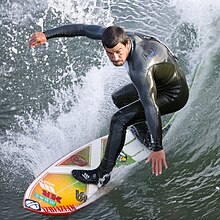

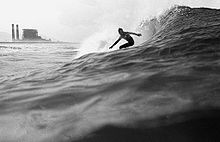


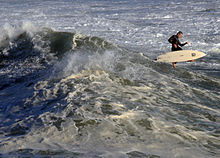

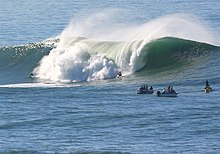

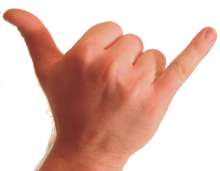

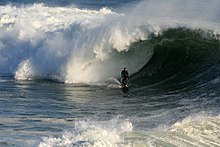

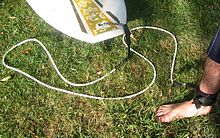



Tidak ada komentar:
Posting Komentar